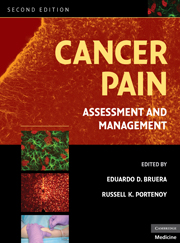Book contents
- Frontmatter
- Contents
- Contributors
- Preface
- SECTION I MECHANISMS AND EPIDEMIOLOGY
- SECTION II EPIDEMIOLOGY AND SYNDROMES
- SECTION III ASSESSMENT
- SECTION IV PHARMACOLOGICAL TREATMENT
- SECTION V OTHER INTERVENTIONAL STRATEGIES
- SECTION VI REHABILITATION AND PSYCHOLOGICAL INTERVENTIONS
- SECTION VII THE ROLE OF ANTINEOPLASTIC THERAPIES IN PAIN CONTROL
- SECTION VIII PAIN IN SPECIAL POPULATIONS
- 22 Cancer pain management in the chemically dependent patient
- 23 Cancer pain in children
- 24 Managing cancer pain in the elderly
- SECTION IX DIFFICULT PAIN PROBLEMS
- SECTION X SYSTEMS OF CARE
- Index
- Plate section
- References
24 - Managing cancer pain in the elderly
from SECTION VIII - PAIN IN SPECIAL POPULATIONS
Published online by Cambridge University Press: 06 July 2010
- Frontmatter
- Contents
- Contributors
- Preface
- SECTION I MECHANISMS AND EPIDEMIOLOGY
- SECTION II EPIDEMIOLOGY AND SYNDROMES
- SECTION III ASSESSMENT
- SECTION IV PHARMACOLOGICAL TREATMENT
- SECTION V OTHER INTERVENTIONAL STRATEGIES
- SECTION VI REHABILITATION AND PSYCHOLOGICAL INTERVENTIONS
- SECTION VII THE ROLE OF ANTINEOPLASTIC THERAPIES IN PAIN CONTROL
- SECTION VIII PAIN IN SPECIAL POPULATIONS
- 22 Cancer pain management in the chemically dependent patient
- 23 Cancer pain in children
- 24 Managing cancer pain in the elderly
- SECTION IX DIFFICULT PAIN PROBLEMS
- SECTION X SYSTEMS OF CARE
- Index
- Plate section
- References
Summary
Introduction
Western populations are experiencing a progressive increase in median life span, and it is predicted that the percentage of individuals aged 60 years and older will reach 15.2% in 2030. With aging, there is a decline of organ reserves and functional impairment, contributing to a decreased adaptability to both disease and its treatment. The aging of the population and advances in modern medicine have resulted in chronicity of some illnesses, such as cancer, end-stage heart and lung diseases, and renal insufficiency. Older cancer patients may experience a number of devastating physical and psychosocial symptoms before they die. When symptoms are not recognized and treated appropriately, there is an increase in suffering among elderly patients and their primary caregivers. Cancer pain management in the elderly is truly a public health and quality-of-care issue. Pain in cancer patients is not yet treated effectively.– Most of the cancer patients and cancer survivors are 65 years old or older. Approximately 60% of the estimated 10.8 million cancer survivors in the United States today are older than 65 years. Multidisciplinary evaluation of the malignancy and its distressing symptoms and an interdisciplinary approach to the host's symptoms, including pain, constitute the most effective approach to assessing and treating elderly cancer patients to maximize the best possible quality of life. This book chapter highlights the important issues concerning pain management in elderly cancer patients, the appropriate assessment tools and therapeutic options, and their impact on quality of life.
- Type
- Chapter
- Information
- Cancer PainAssessment and Management, pp. 444 - 454Publisher: Cambridge University PressPrint publication year: 2009



